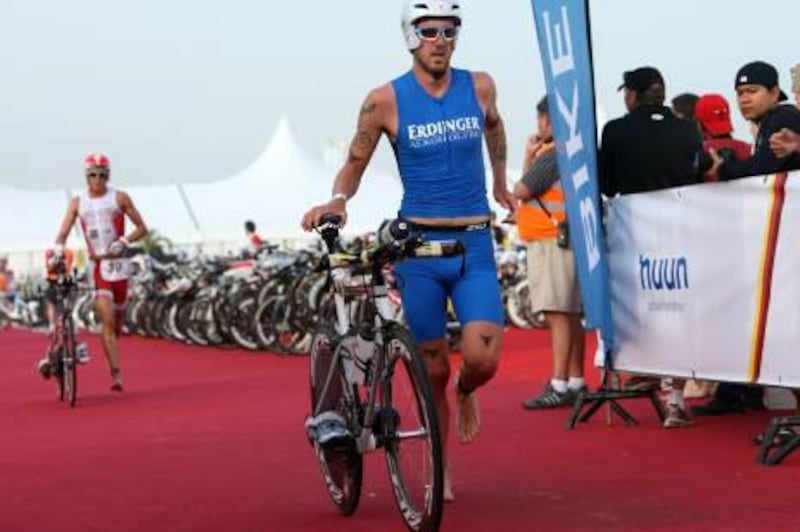ABU DHABI // In any other hotel in the world, it would have qualified as a downright oddity.
Not this week, and certainly not in this locale.
A slender woman walked through the lobby of a towering inn on the Corniche on Thursday with a state-of-the-art bicycle wheel in one hand while pushing a baby trolley with the other.
Serving as home base to many of the record 2,050 athletes entered in the Abu Dhabi International Triathlon (ADIT), the hotel was brimming with born triathlon multitaskers, but the wheel in the woman's left hand was more than a little symbolic.
The ADIT has fast become one of the cannot-miss events on the global triathlon circuit for many reasons.
But it is the lengthy bicycle portions of the race, which begins 6.40am, Saturday, on the Corniche public beach, that makes it altogether different from the rest.
When globally known endurance athlete Conrad Stoltz, who specialises in off-road races, began training for the 223-kilometre ADIT four months ago, his five-hour bike workouts often had an unusual ending.
"I would be so tired at the end," the 39-year-old South African said, "I would lie down in the road."
This admission from a man who is such a grinder as a competitor, he answers to the nickname, "The Caveman".
But, like his brethren, he knew working overtime on the bike was the crucial cog.
The ADIT features several different competitive categories for professionals and hobbyists alike, but the emphasis will centre on the long and short-course events in both genders, which feature bike segments that are lengthier than traditional triathlon distances.
"What makes this race so unique is how important the bike is," said Chris McCormack, 39, a two-time winner of the Ironman World Championship in Hawaii, the biggest event in the world.
"It is a very aggressive, fast race.
"When you get off the bike here, you are absolutely cooked."
For the long-course competitors, the bike segment is 200 kilometres, or 20km longer than a standard ironman distance. In the 115.5km short-course competition, which will feature the Olympic gold medallist Alistair Brownlee, the bike portion is 100km, or a full 60km more than the standard Olympic triathlon distance on two wheels.
"You hope it's a day when you have good legs," Brownlee laughed.
At this venue, then, the winners must pedal to the metal - in this case, the considerable sack of coins at the finish line.
At a pre-race publicity session, a half-dozen of the elite triathletes extolled the virtues of the race and the city, which is perfectly suited for a race at this time of year, but the ADIT also features US$230,000 (Dh844,000) in prize money, one of the biggest purses in the sport.
On the long course, the winner in the two gender divisions gets $50,000, or more than three times the standard ironman triathlon prize of $15,000.
That figure gets everyone's attention.
"So, the good guys will come," said the Belgian standout Frederik Van Lierde, who won the ADIT in 2011 and finished fifth in his two other appearances.
For the long-course competitors of both genders, it is a brutally long day - the race takes around six to seven hours for the top athletes, and Van Lierde prefers to be finished with breakfast a full three hours before the race starts. That means starting his pre-race meal of white toast and bananas at 3am before he hits the water at dawn.
"You get used to it," he said.
The women's long-course division is loaded with veterans who are familiar with the rigours of this particular event.
Australia's Nikki Butterfield, who won the women's long-course title last year, is entered, as is Caroline Steffen, who finished third.
Butterfield planned to skip the event while trying to add another child to her family, but when that was not in the cards, she started training in late November after a four-month hiatus.
Her endurance level is about to be determined under live fire.
"I'm not sure how much it dropped off in the four months I had off," Butterfield said.
The ADIT reputation has done nothing but climb steadily in its four years.
The 2,050 entrants, representing 76 countries, are event records.
Van Lierde, having entered all four race iterations, recalled the swimming stage the first year, held in the lagoon at the Emirates Palace.
"Just a couple of people, not too many folks," he said. "It's a big, huge race now, with everything you expect when you come to a big event."
Sultan Al Muhairi of the Abu Dhabi Tourism and Culture Authority, which conducts the event, was particularly pleased that the field had topped 2,000 for the first time and that area entries continue to climb, this year topping the number of foreign applicants.
"Meaning that word of mouth for this event continues to spread," Al Muhairi said.
Follow us
[ @SprtNationalUAE ]





